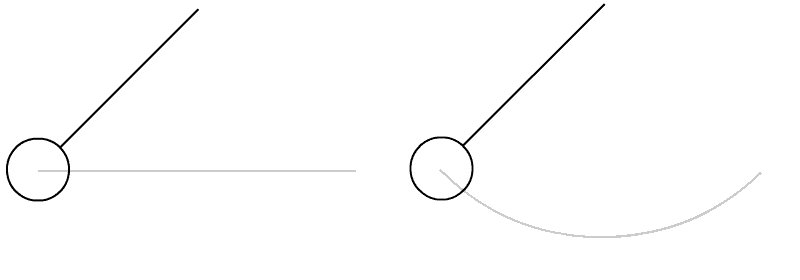Even with all the advanced technology at disposal, creating excellent animation that evokes emotions is just about sticking to the basics. And perhaps this is why, even to this day – from 1981’s book ‘The Illusion of Life: Disney Animation’ of Walt Disney’s legends Frank Thomas and Ollie Johnston – “Twelve Basic Principles of Animation” remains just as relevant as ever.
These principles, introduced to blend the law of physics with abstract issues of creating animation, was simplistically intended to achieve more realistic graphics. Whether you’re a beginner who’s trying to learn the game or are a professional on his way to create a kickass animation, these are 12 key principles you must understand and adhere to.
Here are 12 basic principles of animation:
- Squash and stretch
Every object has weight and mass. It has flexibility and gravity pull. This principle gives the audience a sense of weight and volume of the object. ‘Squash and stretch’ is considered as the most important of all the basic animation principles.
This is a bouncing ball without ‘squash and stretch’…

(Courtesy: Gfycat)
This is a bouncing ball with ‘squash and stretch’…

(Courtesy: Gfycat)
- Anticipation
You cannot take your audience to the main action without first preparing them for it. You must give them clues about what will happen next so as to peak their emotions. For example, for the TV to be turned on, the button on the remote must be clicked; to kick a football, the leg of the subject must first be pulled back. This principle ‘anticipation’ helps animators do exactly that to make the action look more realistic.

(Courtesy: Gfycat)
- Staging
A frame can be shared by many objects and characters. But one of them is the main focus where you want your audience to concentrate. How do you get them to do that? By staging the scene accordingly where you make it clear what/who is the most important part of this scene. The objective of staging is to blur out the details from the audience’s consciousness and get them to attend what’s more important per your storyline.

(Courtesy: Gfycat)
- Straight ahead action and pose to pose
The principle states that there are two ways to handle drawing. One, you draw frame-by-frame from the start to end. This is straight ahead action. With more detailing, it helps create a better illusion of movement and fluidity, making the scene more realistic. Pose to pose technique is when you first draw the beginning and end frame, as well as the key frames that define your scene. Then you complete the remaining. By giving more control within the scene, this helps you make the movements more dramatic and emotional.

(Courtesy: Gfycat)
- Follow through and overlapping action
To have a fluid consistency in your scenes, these are important. The principle of follow-through is when a subject stops the motion, not everything of/on that subject will stop all at once. Some may take a few more frames than the others. Overlapping action states that when the subject is moving, not ever part of/on that subject will maintain the same acceleration. For instance, if the subject is running, his hands might move much faster than legs.

(Courtesy: Gfycat)
- Slow in and slow out
An abrupt-ending motion kills the realism of a scene. This is what this principle of animation solves. Often called ‘ease in and ease out’, ‘slow in and slow out’ emphasizes to add more frames to the beginning and finish of an action sequence – especially the extreme poses – to make the movements of the subject more realistic. It’s similar to, say, driving a car. When you start, it takes time to accelerate; when you stop, it takes time to de-accelerate and halt.

(Courtesy: Gfycat)
- Arc
This technique helps eliminate any erratic movement of the subject and achieve higher fluidity. And this is much similar to any natural, life-like action, which follows the law of physics of an arced path. Per the principle, animations should be no different. For example, when the subject throws a ball, the ball must follow an arc as the gravity pulls it down – and NOT drop erratically.

(Courtesy: Gfycat)
- Secondary action
This principle helps animators add more dimension and depth to the main action of the subject. The secondary action emphasizes the primary action – adding more value to it to enhance its dramatization, emotion and impact – WITHOUT distracting the audience or taking away the attention from the primary action. For example, when the subject is speaking, that’s the primary action. To add more depth to it, his eye movement can be changed, which is secondary action, as a reaction to the primary one.

(Courtesy: Gfycat)
- Timing
The speed of the movement of your objects must be in sync with how it happens in the real world. Otherwise, it would not look realistic. For instance, if you throw a heavy ball in the air, it will drop much quicker and faster vs. when a light ball is thrown. This principle of animation is very important to control and establish the emotion, reaction and personality of your subjects. Note: That said though, you sure can exaggerate your subjects if it’s an imagery world; you must maintain consistency though.

(Courtesy: Gfycat)
- Exaggeration
A dull, mundane scene from a regular day can be made full of life and interesting through exaggeration in the animation. The principle states exactly what the word “exaggeration” means – representing an action in an excessive manner. It helps your scenes avoid looking static. Now, how exaggerated your subjects can depend on the scene and storyline. Frank Thomas and Ollie Johnston believed the animation should stay true to real-life but only have an extreme form that makes it more interesting and lively.

(Courtesy: Gfycat)
- Solid drawing
You might not necessarily be making a 3D animation but you must consider the 3D forms of your objects. This makes the scenes look more realistic. Now, of course, drawing in three-dimensional space is easier said than done. You must take into consideration various key elements like weight, volume, lights, shadow, form, the anatomy of your objects, and more. While the advanced software that we have now has made this quite easier. But to be more efficient, professional animators usually advise the beginners to take art and sketching classes.

(Courtesy: Gfycat)
- Appeal
The appeal of a subject in animation is equivalent to the charm of an actor in a movie. The characters in the animation must be interesting, real-like and compelling. They must appeal to the audience. This is what this principle states. Of course, there are no hard rules to get this right. You must focus on every aspect of the animation – from the story to the movements of the subjects to little details like their expressions. The experienced animators, who are much more intuitive after years of working, are better at getting the appeal of characters correct.

(Courtesy: Gfycat)
Conclusion
These are 12 basic principles of animation by Walt Disney’s Frank Thomas and Ollie Johnston. They form the fundamental of creating interesting and engaging animations. If you’re looking to become a professional, it’s essential that you ace these principles, refine them with your own unique approach and then create and then create some more.
Written By :
Preeti Taneja
About the blogger – The bogger holds an Engineering degree and has an experience of working with various technologies with medium to large enterprises. Creativity and love for animation is her passion.

